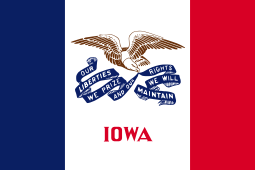Guy Gillette
Guy Mark Gillette (February 3, 1879 – March 3, 1973) was a Democratic U.S. Representative and Senator from Iowa. In the U.S. Senate, Gillette was elected, re-elected, defeated, elected again, and defeated again.
Guy Gillette | |
|---|---|
_LCCN2016871060_(cropped).jpg) | |
| United States senator from Iowa | |
| In office January 3, 1949 – January 3, 1955 | |
| Preceded by | George A. Wilson |
| Succeeded by | Thomas E. Martin |
| In office November 4, 1936 – January 3, 1945 | |
| Preceded by | Richard L. Murphy |
| Succeeded by | Bourke B. Hickenlooper |
| Member of the U.S. House of Representatives from Iowa's 9th district | |
| In office March 4, 1933 – November 3, 1936 | |
| Preceded by | Ed H. Campbell (Redistricting) |
| Succeeded by | Vincent F. Harrington |
| Personal details | |
| Born | Guy Mark Gillette February 3, 1879 Cherokee, Iowa, U.S. |
| Died | March 3, 1973 (aged 94) Cherokee, Iowa, U.S. |
| Political party | Democratic |
Personal background
Born in Cherokee, Iowa, he attended public school and graduated from Drake University Law School in Des Moines in 1900.[1] He was admitted to the bar in 1900 and commenced practice in Cherokee. During the Spanish–American War, he served as a sergeant in the Fifty-second Iowa Regiment in the United States Army, but never saw combat.[2] He volunteered to fight against the British in Africa in the Boer War, but was turned down.[2]
Returning to Iowa, he engaged in agricultural pursuits and was the city attorney of Cherokee in 1906–1907. He became the prosecuting attorney of Cherokee County from 1907 to 1909 and a member of the Iowa State Senate from 1912 to 1916.
During the First World War, he served as a captain in the United States Army. He ran unsuccessfully for Iowa State Auditor in 1918, and returned to Cherokee to farm.[3]
Service in the U.S. House, then U.S. Senate (1933–1945)
In 1932, in the Roosevelt landslide, he was elected as a Democrat to represent Iowa's 9th congressional district, in heavily Republican northwest Iowa. He was re-elected in 1934, and served nearly all of that term. He resigned upon his election to the United States Senate on November 3, 1936 to serve out the remainder of the term of Senator Richard Louis Murphy, who had died in an auto accident. Nearly two years remained in Murphy's term, which would end January 3, 1939. Although he generally supported the New Deal, he opposed the new wage and hours bill, a new farm bill, and aspects of the Social Security system.[3]
In 1938 the Roosevelt Administration targeted Gillette for replacement because of Gillette's vote against Roosevelt's plan to expand the Supreme Court and other positions.[4] He nevertheless defeated Roosevelt's choice for the Democratic nomination, Congressman Otha D. Wearin, and was narrowly elected to his first full Senate term. During that term, his conflicts with the Roosevelt Administration expanded, on topics as diverse as the terms of the Neutrality Act,[5] Roosevelt's pursuit of third and fourth terms,[3] and choices for judgeships.[6]
After the Japanese attack on Pearl Harbor (where, coincidentally, Gillette's brother Captain Claude Gillette managed the Navy yard), Gillette became "more of an internationalist."[3] Nevertheless, he used his chairmanship on a Senate subcommittee to aggressively challenge the Roosevelt Administration's failure to prepare for the prospect of a Japanese seizure of the source of the nation's rubber imports by developing synthetic farm-based alternatives.[3] In April 1943 a confidential analysis by British scholar Isaiah Berlin of the Senate Foreign Relations Committee for the British Foreign Office succinctly characterized Gillette:
- [He] resembles Van Nuys in that he is a typical Mid-Western Senator with a moderately steady Isolationist voting record, although he is not an articulate opponent of the Administration's policy. Unlike Van Nuys, he is a supporter of reciprocal trade pacts but shares his suspicion of the President. A simple, confused, but very honest Presbyterian of considerable character, he views the corn interest, which he represents, with an almost religious devotion. He leads the Senate Lobby interested in producing synthetic rubber out of corn, and coming from the Republican corn belt, is virtually a Republican in sentiment and conduct. He is not at all anti-British, but as isolationist as his general environment. His speeches in Congress take the form of thinking aloud. On foreign policy he is not a bigoted anti-Rooseveltite but is exceedingly uncertain.[7]
Like several others who had opposed Roosevelt's efforts to aid Great Britain before Pearl Harbor but faced wartime elections, Gillette lost his next race, in 1944, to Iowa Governor and Republican Bourke B. Hickenlooper.[8]
Between terms
Within days of Gillette's first defeat, Roosevelt nominated him as the chairman of the three-member Surplus Property Board, prompting the Washington Post and a Life Magazine editorial to quip that the president was confusing the problem of surplus property with the problem of surplus politicians.[9] He took an early dislike to the job,[10] and complained that he was often outvoted by the two other members.[11] After resigning from the Surplus Board in May 1945, he became president of the American League for a Free Palestine, serving until the Committee's work ended with the establishment of the state of Israel in 1948.
Return to the Senate (1949–1955)
He made a political comeback in 1948, unseating former governor George A. Wilson from Iowa's other Senate seat. In 1951 his Subcommittee on Privileges and Elections conducted an investigation of Wisconsin Senator Joseph McCarthy's campaign practices.[3] Gillette served until January 3, 1955, after his own bid for re-election was thwarted by U.S. Representative Thomas E. Martin of Iowa City. His defeat was considered an upset because it conflicted with polls.[12] For the last time, it left every Iowa seat in Congress in Republican hands. From 1951 onwards Senator Gillette was one of the first to call for an North Atlantic Assembly.[13]
Post-Senate
Following his second defeat, Gillette initially remained on Capitol Hill, serving as counsel with the Senate Post Office and Civil Service Committee (from 1955 to 1956) and the Senate Judiciary Committee (from 1956 to 1961).
He retired and resided in Cherokee until his death at age 94 on March 3, 1973, and was interred in Oak Hill Cemetery.[14]
References
- "Gillette, Guy Mark, (1879–1973)". Biographical Directory of the United States Congress. Retrieved September 2, 2012.
- Oral History of Stewart McClure, Part 1 (Service on Gillette Senate Staff), at 5.
- Mark R. Finlay, "Guy Mark Gillette," in The Biographical Dictionary of Iowa, p. 188 (2008).
- "Iowa's Microcosm," Time Magazine, 1938-06-13.
- "Rebels and Ripsnorters," Time Magazine, 1939-7-24.
- "SEC seat warming," Time Magazine, 1941-04-21.
- Hachey, Thomas E. (Winter 1973–1974). "American Profiles on Capitol Hill: A Confidential Study for the British Foreign Office in 1943" (PDF). Wisconsin Magazine of History. 57 (2): 141–153. JSTOR 4634869. Archived from the original (PDF) on October 21, 2013.
- "The New Senate," Time Magazine, 1944-11-13.
- Editorial, "Surplus Property," Life Magazine, 1944-12-18 at p. 20
- "Inside Washington," Valparaiso Vidette-Messenger, 1945-04-16 at p. 7.
- "Under the Capitol Dome," Ames Daily Tribune, 1945-07-20 at p. 4.
- "Gillette is Upset, GOP wins State," Waterloo Daily Courier, 1954-11-03, at 1-2.
- Charman and Williams, Sarah and Keith. "THE PARLIAMENTARIANS' ROLE IN THE ALLIANCE" (PDF). https://www.nato-pa.int. North Atlantic Assembly. Retrieved 27 February 2020. External link in
|website=(help) - "Guy Mark Gillette (1879–1973)". Find A Grave. Retrieved 11 August 2018.
Bibliography
- Harrington, Jerry. “Senator Guy Gillette Foils the Execution Committee.” Palimpsest 62 (November/December 1981), pp. 170-80
External links
| Wikimedia Commons has media related to Guy Gillette. |
- United States Congress. "Guy Gillette (id: G000205)". Biographical Directory of the United States Congress.
- A film clip "Longines Chronoscope with Guy M. Gillette" is available at the Internet Archive
| Party political offices | ||
|---|---|---|
| Preceded by Richard L. Murphy |
Democratic nominee for U.S. Senator from Iowa (Class 3) 1936, 1938, 1944 |
Succeeded by Albert J. Loveland |
| Preceded by Clyde L. Herring |
Democratic nominee for U.S. Senator from Iowa (Class 2) 1948, 1954 |
Succeeded by Herschel C. Loveless |
| U.S. House of Representatives | ||
| Preceded by Charles E. Swanson |
Member of the U.S. House of Representatives from Iowa's 9th congressional district 1933–1936 |
Succeeded by Vincent F. Harrington |
| U.S. Senate | ||
| Preceded by Richard L. Murphy |
U.S. senator (Class 3) from Iowa 1936–1945 Served alongside: Lester J. Dickinson, Clyde L. Herring, George A. Wilson |
Succeeded by Bourke B. Hickenlooper |
| Preceded by George A. Wilson |
U.S. senator (Class 2) from Iowa 1949–1955 Served alongside: Bourke Hickenlooper |
Succeeded by Thomas E. Martin |


